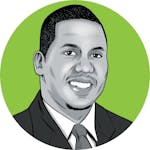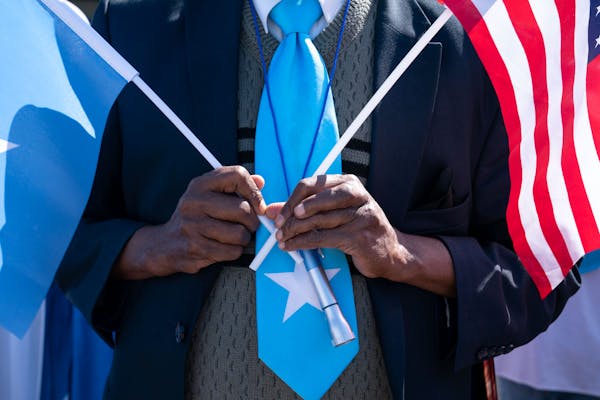On a balmy morning in St. Paul, Mimi did her makeup.
"I try to keep myself up," she said.
Her eyebrows were perfectly sculpted and her eyeshadow popped — magenta and sparkles.
She spoke softly as she detailed her journey, while I sat next to her tent not far from the city's downtown hub.
It started in Chicago after her mother died. She and her siblings moved to Minneapolis to live with an aunt. But the relationship soured and her aunt kicked her out of the house. Mimi was just 16 years old then. For 17 years, she has experienced homelessness and endured the stigma that follows those without a place to call their own.
"Automatically, they just reject us," Mimi told me. "It makes us worse than we are. It's like we're a bunch of nobodies."
On Wednesday, I walked through St. Paul with Josie Johnstone and Meghan Dunn, both street outreach practitioners at People Incorporated Mental Health Services, to gain a greater understanding of homelessness in the Twin Cities.
While I want to know the obstacles attached to one of our community's most urgent challenges, I also think the line between reporting and exploitation is thin. But I know we cannot discuss homelessness without telling the stories of those living through it.
That life is more complicated than many of us know.
"In Ramsey County, the centralized waiting list for people experiencing homelessness is called Coordinated Entry," said David Katzenmeyer, a program manager with People Incorporated Mental Health Services in St. Paul. "From the time you sign up on that, about the average time is nine months to actually get a referral to housing."
I asked him if he meant nine weeks, not nine months. "Nine months," he repeated.
And nine months is just the average.
"Sometimes," said Mimi, who has battled through subzero temperatures in the winter without shelter, "it takes even longer than that."
I met Mimi while I was with Johnstone and Dunn.
They carry hikers' backpacks filled with supplies: water, medicine, socks. But I was most struck by their love for the people we saw that morning. They are relentless in their effort to humanize them.
I could see why Johnstone is studying to be a therapist. At each tent, she would kneel down and call out the names of those she knew as the sun illuminated the tattoos that decorate her right arm. She addressed them with a tone that suggested this is more than a job for her.
"You need anything?" she asked one man.
"I'm doing OK," he said.
Their vibes were always hopeful. And their supplies were as important as their empathy toward those we met.
"Jonathan!" Dunn said to one man she passed. "How are you?"
That recognition alone is meaningful, Dunn told me.
"I talk to some people who are surprised when I remember their names," she said. "And I'm like, 'Of course, I remembered your name. I see you all the time.' "
Dunn and I discovered we were both athletes at Minnesota State University, Mankato, in 2001.
We talked about the mood on campus we both experienced in the days that followed the death of Korey Stringer at Minnesota Vikings training camp. Some of the people we encountered in St. Paul were as young as we were then.
Noah, 19, wondered where he would take his tent that day if police cleared the area, which is common, I'm told. He said he was young when his father died of an overdose, forcing him into a sudden spiral. Over time, drug addiction ensnared his family. His whole life was in a shopping cart.
We connected over our interest in hip-hop. He also loves science and space exploration, so I asked him if he thought we would ever have the capacity to support life on Mars.
"If we don't deal with our climate," he said, "we're not going to be here to find out."
He said he wants to help people one day. That's his goal. And he also wants to survive.
Noah pointed to a tree about 50 yards from where we talked. He feels safe in that tree, which he climbs at night sometimes when he wants uninterrupted sleep.
Life can be explosive and unpredictable where he lives, he said. Mimi also discussed that danger, compounded for women.
I asked her if she had any words for those who want to help but don't know where they should direct their energy.
"Just help us get our voices heard," she said.
This is the portion of the column where I figured I'd have something profound to say. I thought I'd have concrete steps for people to take to change the circumstances for those experiencing homelessness in our communities — beyond donating to organizations or telling our lawmakers we care about these issues. But I do not. I am still learning.
Instead, I just hope whenever we pass encampments or bridges or parks or any place where those experiencing homelessness might live in our communities, we remember that there are people down there.
Because Mimi still does her makeup every morning and Noah still has dreams.
Medcalf: Young adults' demand for work-life balance offers lessons for us all

Medcalf: Were up to 200 kids really actively fighting in Roseville?

Medcalf: Deadly men with guns were once boys who did not know what to do with their anger

Medcalf: Why Black History month is needed


